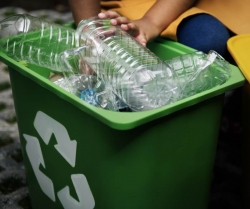- Home
- Tutorial
- Resource Guides
- Focus Areas
- LSF Programs
-
Professional
Development - Review Process
-
A project of LSF

Search for Resources
Description
Although plastic is a versatile and economical substance that we use every day, Earth has also become inundated with our plastic waste that is destroying ocean ecosystems, harming wildlife and polluting sensitive habitats. In this activity students learn that plastic recycling is a complex process that is only effective when items are easily converted and reused and humans sort these products correctly. By examining the symbols and letters on a variety of containers and sketching the life cycle of a plastic bottle, pupils develop an understanding of the many types of plastics and the environmental impacts of improper disposal. As students become aware that problems with plastic occur from beginning to end, they will realize that healing our “plastic world” needs a commitment from all of us to reduce our dependence on this modern convenience.
General Assessment
Recommendation of how and where to use it
This activity supports Grade 7-9 Science units exploring human impacts on ecosystems and the use of non-renewable resources. Students also learn about manufacturing processes that convert oil and gas into compounds, which when mixed with other materials create a wide range of plastic types such as polyvinyl chloride (PVC). The activity also leads to discussions about why sustainable consumption is so important to the health of our planet.
One of the worst forms of plastic pollution are single use items. Plastic baggies are frequently used to pack school lunches and snacks and discarded after use. This issue could become the basis of a class project that engages pupils in developing a sustainable alternative to conventional food wraps. In cooperation with community volunteers, students could create beeswax cloth bags for food storage. These reusable items could then be dispersed to peers and teachers at lunch, along with information about reducing plastic use at home and school.
Relevant Curriculum Units
The following tool will allow you to explore the relevant curriculum matches for this resource. To start, select a province listed below.
- Step 1Select a province
- Alberta
- Step 2Select a grade level
- Grade 7
- Step 3Select a subject
- Science
- Step 4Relevant matches
- Interactions and Ecosystems
- Grade 9
- Step 3Select a subject
- Science
- Step 4Relevant matches
- Environmental Chemistry
- Knowledge and Employability Science: Environmental Chemistry (Social and Environmental Contexts Emphasis)
- British Columbia
- Manitoba
- New Brunswick
- Newfoundland & Labrador
- Northwest Territories
- Nova Scotia
- Nunavut
- Step 2Select a grade level
- Grade 7
- Step 3Select a subject
- Science
- Step 4Relevant matches
- Interactions and Ecosystems
- Grade 8
- Step 3Select a subject
- Science
- Step 4Relevant matches
- Interactions in Our Environment
- Grade 9
- Step 3Select a subject
- Science
- Step 4Relevant matches
- Chemistry and the Environment
- Knowledge and Employability Science: Environmental Chemistry (Social and Environmental Contexts Emphasis)
- Ontario
- Step 2Select a grade level
- Grade 7
- Step 3Select a subject
- Science & Technology
- Step 4Relevant matches
- Life Systems: Interactions in the Environment
- Grade 9
- Step 3Select a subject
- Science
- Step 4Relevant matches
- :Biology: Sustainable Ecosystems
- Prince Edward Island
- Quebec
- Step 2Select a grade level
- Grade 9
- Step 3Select a subject
- Science & Technology
- Step 4Relevant matches
- Applied Science & Technology: The Material World
- Saskatchewan
- Yukon Territory
Themes Addressed
Waste Management (1)
- Rethink, Reduce, Reuse, Recycle

